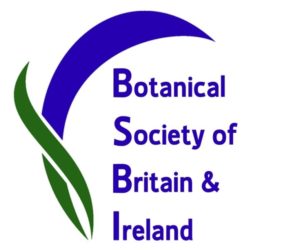Kirkcudbrightshire Botany Group at Sandyhills, 28th July 2023
The purpose of the meeting was partly to continue our ongoing coastal survey, but also to gather botanical data because there is a proposal to increase the number of caravans in the bay. We covered two monads: NX8955 and 8954 and we concentrated on the shore habitats of each.
We began by looking at the area of saltmarsh in NX8955. This contains a large swathe of Sea Club-rush Bolboschoenus maritimus, amongst which we were delighted to come across one plant of Wild Celery Apium graveolens, which is rare in Kirkcudbrightshire and included in the Scottish Biodiversity List. Further south, the marsh comprises a short turf area, much divided by channels and dominated by Common Saltmarsh-grass Puccinellia maritima with abundant Sea Milkwort Lysimachia maritima and occasional plants of Sea Aster Tripolium pannonicum. There were also a number of flowering clumps of Common Sea Lavender Limonium vulgare with dense flowering spikes and yellow anthers, but we looked in vain for Lax-flowered Sea-lavender L.humile with its longer, less dense flowering branches and dark red/brown anthers.
We also found Greater Sea-spurrey Spergularia media with large flowers and winged seeds, but it wasn’t until right at the end of the day that we came across Lesser Sea-spurrey S. marina with much smaller flowers and unwinged seeds. There were also many clumps of Distant Sedge Carex distans which we examined carefully, in order that, when we later searched on the rocky side of the bay for Dotted Sedge C. punctata, we would be able to distinguish between these rather similar species. We found a small amount of the other characteristic seaside sedge, Long-bracted Sedge Carex extensa.
Other species found in this area included Parsley Water-dropwort Oenanthe lachenalii, Brookweed Samolus valerandi and Grass-leaved Orache Atriplex littoralis.
As we walked south, we reached the next monad NX 8954 and crossed the bridge across a stream. The shore at this point is a mixture of bare sand, rocks and short turf, and it grades into scrubby woodland behind. At the edge of the woodland were several beautiful flowering plants of Bloody Crane’s-bill Geranium sanguineum.
We searched the short turf carefully and we were lucky enough to find a few plants of Seaside Centaury Centaurium littorale and several patches of a flat-sedge, Blysmus sp. The large number of spikelets and the channelled rather than rolled leaves indicates Flat-sedge Blysmus compressus, but this species is usually associated with freshwater habitats rather than seashore, so a specimen has been forwarded to the BSBI referee for checking. (Saltmarsh Flat-sedge B. rufus is the possible alternative).
We were keen to leave enough time to check the north side of the bay for the Nationally Scarce Dotted Sedge Carex punctata which had been last recorded there in 2009, so we backtracked at this point and headed towards Craigneuk Point. We knew that this sedge favours seepage lines in the rocks and we spotted an area of low cliffs which looked promising – and there it was! There were lots of plants with their characteristic yellow-green inflated utricles sticking out at right angles from the stem.
The last area that we looked at was the woodland on the shore below the grassy car park extension. A local resident had told us about this area as he had noticed that it was unusual: tree roots exposed by the waves had reminded him of Mangrove swamps that he had seen in the tropics. It is an area of Alder Alnus glutinosa woodland with a lot of slender trees of a similar age all growing close together. Those on the seaward edge are now within reach of the highest tides, causing their roots to become exposed and there were also many fallen trees which had been completely undermined. Several of these still had green leaves, so it would appear to have happened this year.
It is interesting to note that this must have resulted from a recent change as the trees had grown to maturity before being undermined.
We noticed that the trees here were host to Alder Tongue Gall Taphrina alni for which the NBN distribution map shows only a few local records. There was also a fine Four-banded Longhorn Beetle Leptura quadrifasciata on one of the fallen trunks.
Sandyhills Bay is a very varied and rich area of the coast, with several local and scarce plant species, and we had a very enjoyable and productive day. The list of species recorded reflects a great group effort and my thanks to everyone for their company and excellent plant spotting.

